Category: Music
Best. Concert. Ever.
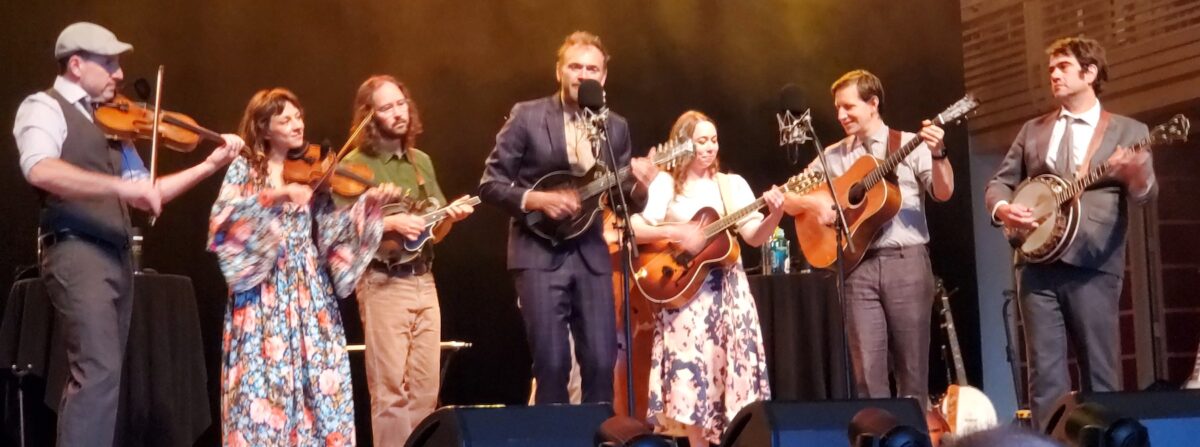
I am a live music junkie, and I’ve been to my share of shows.
I’ve seen Chanticleer sing Renaissance polyphony by candlelight. I’ve seen the National Symphony Orchestra in full swing with Mstislav Rostropovich at the helm. I’ve seen Stephen Stills and Neil Young prowl around a stage, glaring, daring each other to produce a better solo during For What It’s Worth. I saw Chicago, at their height in the early 70’s, horns and Robert Lamm’s B3 raging. I sat in the rain while Tony Rice and Bela Fleck traded licks at Merlefest. I was the old white guy in the middle of the auditorium in Berkeley, losing my mind as George Clinton and Parliament brought The Funk. I sat in the 4th row and watched Yo-Yo Ma play trios with old college friends. Linda Ronstadt bouncing across the stage at Shoreline. Broadway performances of Joseph and the Amazing Technicolor Dreamcoat and Godspell. I saw Ladysmith Black Mombazo sing and dance with Joseph Shabalala directing the entire affair. I was down front to watch the original Seldom Scene perform Wait a Minute. I stood at the stage on the Isle of Man, as Roger Daltry performed the entirety of Tommy. Lyle Lovett and his large (it’s not big) band. Lisa and I stood in a special reserved seating area in Hyde Park and watched Bruce Springsteen sing Twist and Shout with Paul McCartney. I saw Live From Here at the Ryman Theater. Elton John playing solo for a small-ish crowd on the Isle of Man. The Tallis Scholars performing Palestrina near the Severn River. Bruce Hornsby. I’m With Her. Hot Tuna.
And yes, I have seen Doc Watson sing Columbus Stockade Blues.
I know I’ve left some important ones out, but even recalling and typing that list gives me shivers. So I don’t write that title lightly. But there we were on Friday, August 5th, 2022, when the American Acoustic Tour came to Mountain Winery in Saratoga, CA. The line-up was the Punch Brothers, Watchhouse (formerly known as Mandolin Orange), and Sarah Jarosz – maybe that’s enough for you.
It was certainly enough for me and Lisa to grab tickets, toward the front, as soon as we saw it was coming through. Mountain Winery is an extraordinary venue – outdoor, yet intimate. Artists love it, audiences love it, and it brings out the best in both.
But neither my love for the artists on the line-up nor the venue properly prepared us for what was in store.
It began, in the dawn of twilight, with the entire ensemble performing the bluegrass standard Little Birdie. First a cappella, then raging bluegrass, then a cappella again. We cheered, everybody waved and left, except Sarah Jarosz. I’m not doing any band bios here – their individual accomplishments (including her Grammys) don’t tell the story.
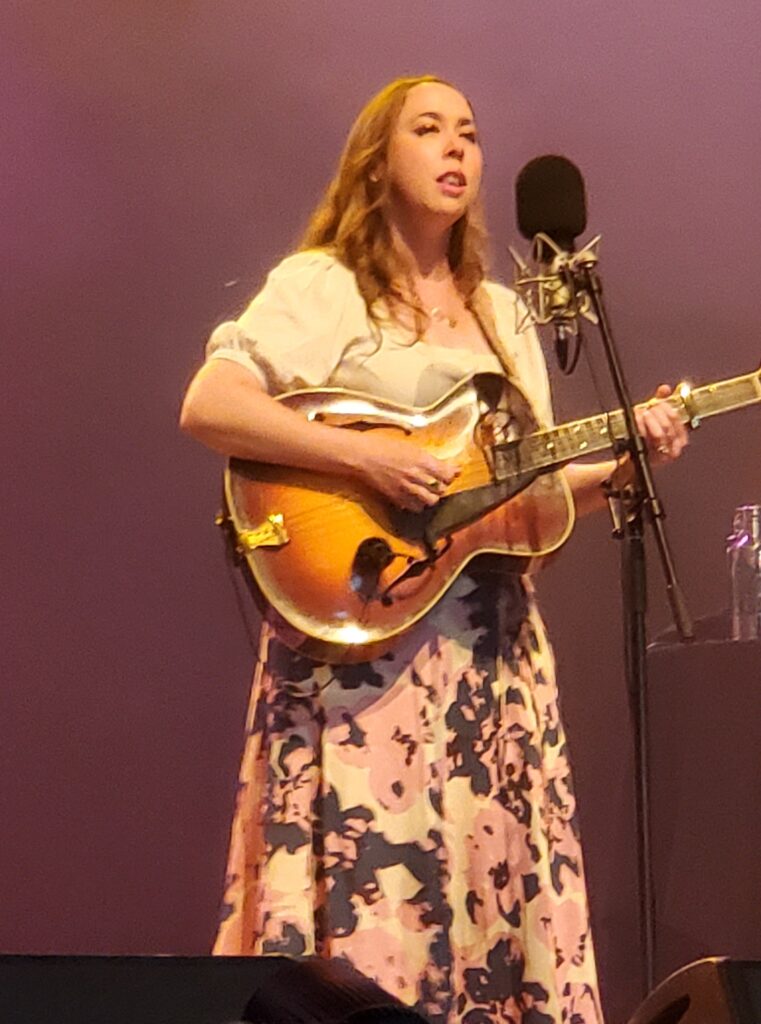
She performed a set of some of her hits, including a recent cover of U2’s Still Haven’t Found What I’m Looking For. She said, “You know the words – go ahead and sing along.”
Which is a good place to tell you about the audience. Audiences for these artists come for the music. They are not there to party, and they make themselves part of the show only when it’s appropriate.
Sarah said to sing along, so we did. We got to the last time around and Sarah stopped singing, just strummed along on her octave mandolin, a beatific smile on her face. She was accompanying the crowd, and everybody was thrilled with that arrangement.
Then Chris Thile came back out, and said, “What about this woman?” We cheered.
And at this point we need to talk about Chris Thile, his genius, and his ego. Yes, he has a big ego, and he likes to be in the limelight. But we humans are not a menu from which you can take what you like and ignore what you don’t. His ego is inseparable from his once-in-a-generation genius. And his ability and willingness to have what the business world calls BHAGs – Big Hairy Audacious Goals.
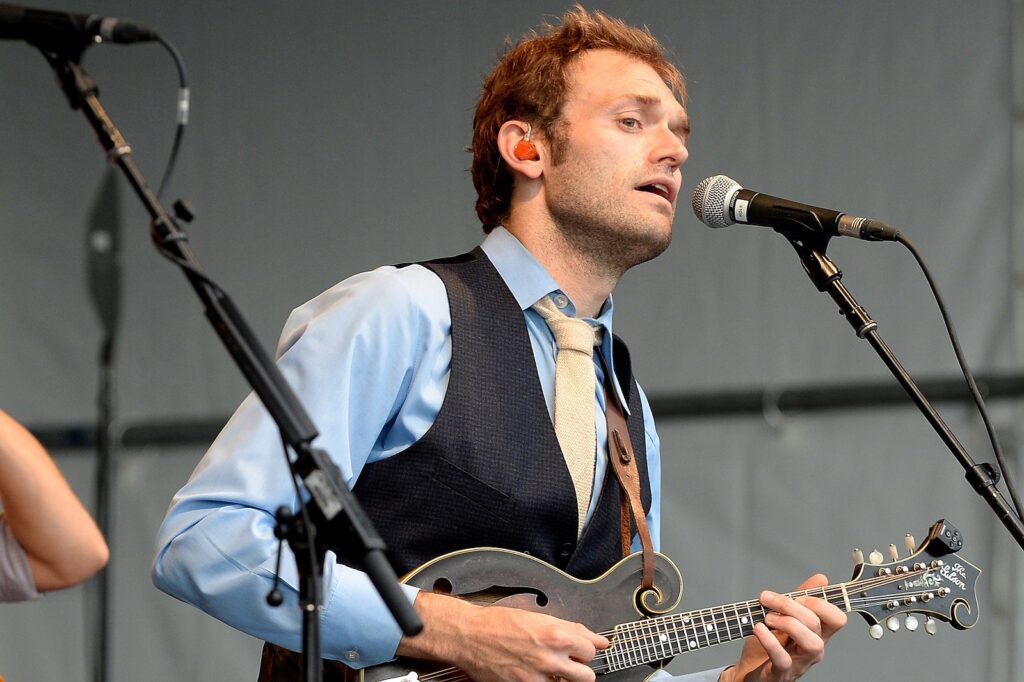
Anybody can put together a tour of great musical acts. But it takes, well, it takes a genius to say, “What if we move people on and off the stage for three hours? We create every possible permutation of the amazing musicians we have, performing each others’ songs, and sometimes, songs that are ‘foreign’ to all of us.”
Exhibit A: Sarah Jarosz has finished her set. Thile is out there. They invite out Watchhouse’s cello player, Nate Smith. Perform a Punch, Jarosz, or Watchhouse tune? Nah, let’s go to the classical section of the record store:
And with that, the show flowed on. Watchhouse, occasionally augmented by Sarah or Chris.
I need to mention that as Watchhouse performed The Wolves, with its chorus line, “But I’ll go out howling at the moon tonight…,” a beautiful half-moon shone down from a clear sky onto the Mountain Winery. I’m sure I wasn’t in the only person in the audience with a lump in my throat. If you’ve never understood what The Wolves is about, neither did I, until I read this. Hint: it’s not a feel-good song.
Then Punch Brothers, weaving their usual acoustic magic, with the audience singing along to My Oh My.
Then the impossible happened… Thile and fiddle player Gabe Witcher began making weird chopping, cutting sounds with their instruments, standing face to face, like Stills and Young, daring the other to do something weirder. As this scene played, Noam Pikelny started the magical drone on his banjo. Sarah walked out, and I realized they were reprising the Live From Here performance of Massive Attack’s Teardrop. As did many in the audience, and we promptly lost our minds.
My wife calls this music, “The chamber music of our time.” Some people will try to squeeze “grass” into the name somewhere. Sure, these musicians can (and do) fire up a bluegrass standard now and again. The instrumentation is there, and they all grew up on bluegrass, so when they play bluegrass and fiddle tunes, it’s as good as you’ll ever hear it.
But Itzhak Perlman playing klezmer music does not make klezmer music western classical music. It makes Itzhak Perlman a genre-hopper, and a genius one at that.
“American Acoustic” might be a great name for the genre, as well as the title of the tour.
One of the most glorious portions of the show was when all 11 musicians were on the stage. At times, there were 4-5 instruments being played arco (bowed), with the rest plucked. I will bet a lot of money that Gabe Witcher, a high-demand composer and arranger in L.A., was responsible for the string arrangements.
There was one song, sadly, I can’t remember which one, that faded to a string quartet of Gabe and Emily Frantz of Watchhouse on fiddle, Nate Smith on cello, and Paul Kowert on bass, all arco. As the plucked instruments subsided, those players stood in a group and watched as the quartet brought the piece to a beautiful, mildly dissonant, heart-rending ending.
Anyway, as anticipated, the show ended with everybody on stage. [Except for Watchhouse’s guitar player, Josh Oliver, and bass player, Clint Mullican.] It started with Chris, Emily, Andrew, and Sarah singing, “Rye whiskey, rye whiskey, rye whiskey I cry…” We all knew where that was going. But what if the Punch classic Rye Whiskey was played not by five great musicians, but nine great musicians? Recall when you saw Punch Brothers playing this live (you have, haven’t you?). Now visualize 2x the horsepower, with the same verve and joie de musique…
Let me put this way: the shadows you see on the back wall behind the stage – that’s how big those musicians really are.
Oh, and Emily Frantz sang Rye Whiskey like Thile had written the song for her. Her presence on stage is, in a word, overwhelming. For this tune, she abandoned the honey of her Tarheel voice and went full moonshine county. Pass that bottle over here.
Sorry, I gotta glance back at that. Watch at 2:50. You have Paul and Nate doing a bass/cello arco duet of the melody, while Andrew stands between them, best seat in the house, just grooving. At 3:08, Gabe and Emily land on it with both feet and we’ve got four masters playing the melody, arco, across three different octaves. Critter, who usually smiles, is grinning from ear to ear. He’s heard and played this tune a hundred times, but man, never quite like this.
The encore, for which I was delighted to see Clint and Josh return, was not a song, but an entire set, and rather than me try to describe it, I’ll pass you over to YouTube.
The second song is Can’t Be Sure by the Sundays. It’s a lovely tune, by an indy band with a passionate cult following. Kinda like… nevermind. I had never heard the tune, so went and listened to the original. The American Acoustic cover was accurate, loving, and brought their own vibe to it. Not surprisingly, Sarah crushed it.
The third encore piece was the Watchhouse classic Wildfire. And here, I want to address those of you who say that Thile’s ego gets in the way. This is a Watchhouse song, Andrew is singing lead, and Chris knows exactly where his place is – to sing “Mmmmm” in the back-up. Then watch at 0:40. Guitarist Josh Oliver is kind of hanging back – Chris steps back and waves him up to the mic. It’s Josh’s band – he gets near the mic. Chris Thile is devoted to the music, and when that means he steps back, he does.
The very last tune looped back around to bluegrass. In this case, classic bluegrass gospel. It was if they were saying, “We know we’ve taken you on a light-speed tour to our own corner of the galaxy. We’ll bring you back home to safe and familiar ground.”
And as they closed the show, Thile held out his hands and emphasized the line, “…where all is peace and joy and love…” It was, without doubt, a final prayer and benediction.
Protected: Catching Shirley by the Heart
One more time!
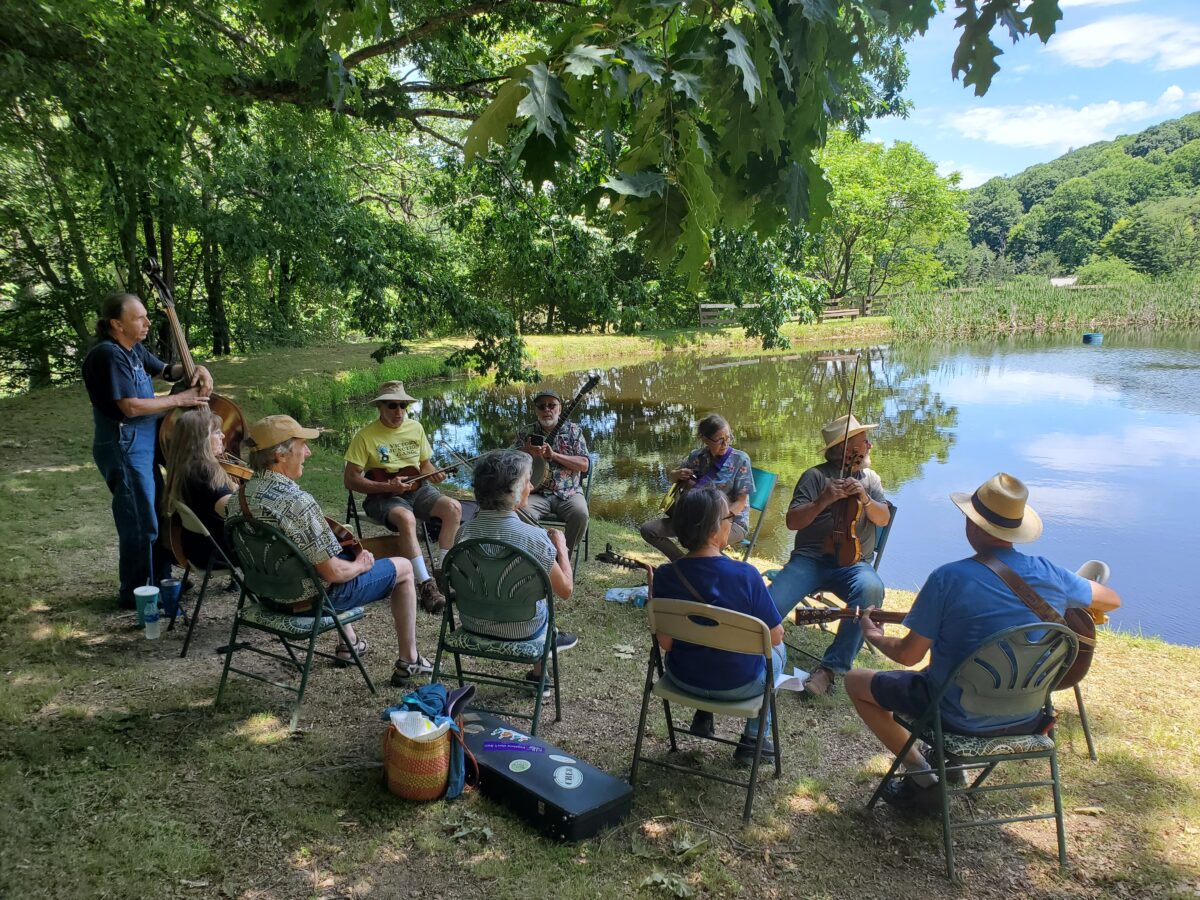
My cousins, Roald and Ellie Kirby, who live in Troutdale, Virginia, invited me to an old-time jam on the last day of my residency in the North Carolina mountains. It was at the homestead of a friend of theirs in Elk Creek, Virginia.
“Do you know Elk Creek?”
“No, but play it one time around and I’ll fake it.”
Even better, their friend, Jerry, lives at the very end of Possum Run Lane.
“Do you know Possum Run Lane?”
“Sure do. Same chord pattern as Old Joe Clark, right?”
I’d show you what it looked like on the drive up, but Google street view stops when you leave VA-21 out of Independence. Me and the Prius made it down the dirt road, dirtier driveway, and cattle barrier with no problems. I think Roald and Ellie were relieved, and perhaps a little surprised, to see that I’d made it there.
There was a pond – Roald, who is an avid fisherman, had just landed a bluegill on a popper. And there was a beautiful 20′ long custom-made picnic table, with more food than the dozen of us could possibly consume. I regret that I didn’t get a picture of it.
They told me that, back in the old days, there’d be a hundred pickers standing around the picnic area, and you couldn’t see the top of the picnic table for the dishes covering it. There’s times in my life when I feel that I was late getting to a party – this was certainly one of them.
However, I did get a picture of my dessert, which was blueberries from Roald’s blueberry patch, and a giant hunk of cherry pie, which Ellie had made from the fruit of their cherry tree.
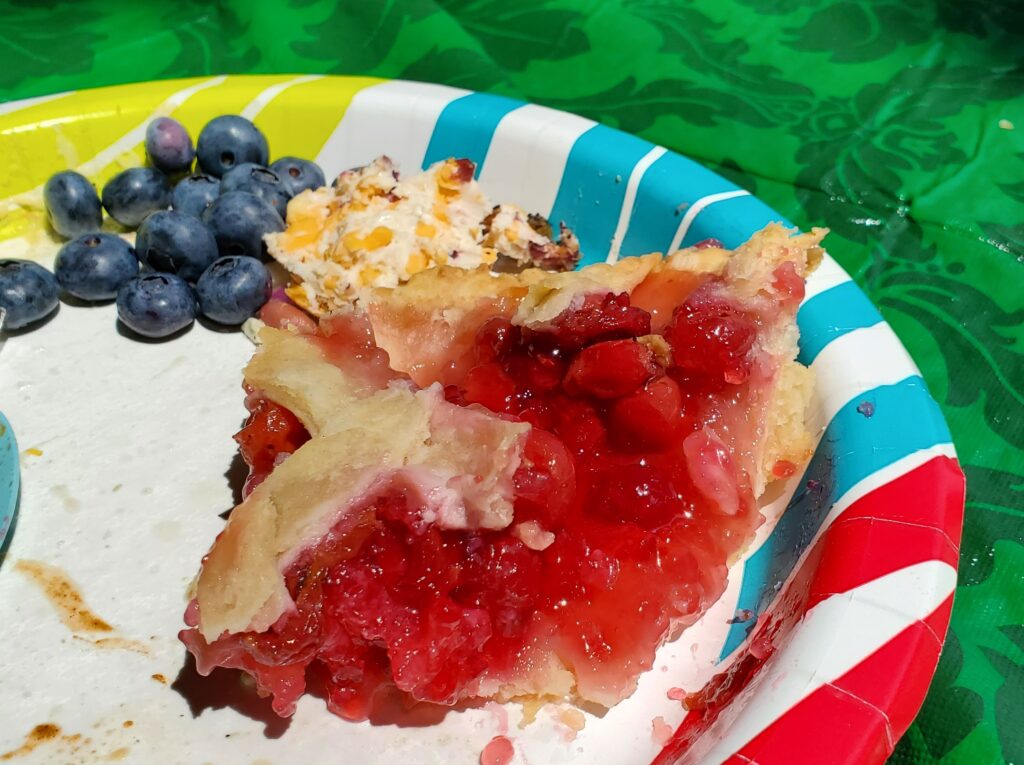
Eventually, the glorious sound of instruments tuning wafted across the pond.
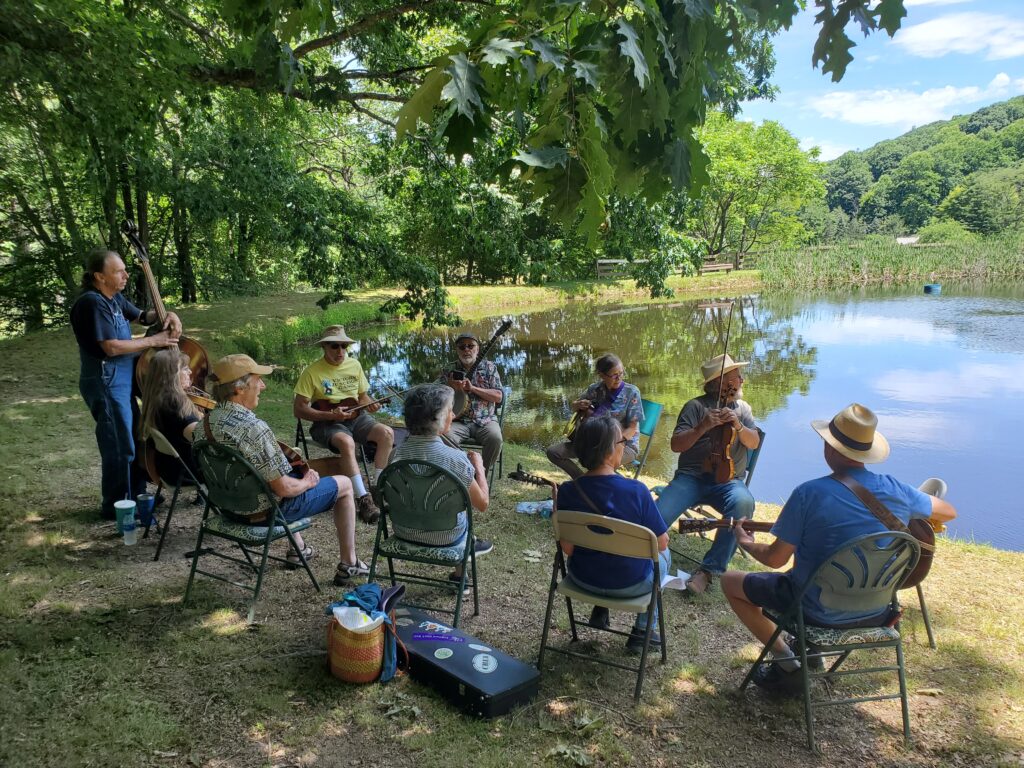
This jam was “In A,” meaning that all the tunes have to be in the key of A. Apparently they have a different key each week, so there’s not the hassle of capo adjustment and retuning. Fortunately, the tunes I wanted to play/hear were in A, so I was content. But no Forked Deer for me this time (it’s in D).
Many jams have a fairly rigorous protocol of song selection passing around the circle – this is one of ’em. It’s bad form to suggest a tune until it’s your turn, but fortunately I really enjoyed the picks that other people made.
At some point, I noted that when I picked with the Irish/Celtic musicians in the Isle of Man, they always stopped and applauded and/or cheered after every tune. I said that I missed that about bluegrass jams in the U.S. For no reason that I understand, the protocol there is that the song ends, then everybody looks down at their instrument and tunes. There’s never any acknowledgment of the great music that just happened.
“Well, sometimes Rita will say, ‘Woo-hoo!’ You can do that if you wish. “
“Excellent – I’ll do that.”
“Okay, but don’t overdo it.”
I just followed Rita’s lead, and whenever she’d say “Whoo-hoo” after a tune, I did too. All things in moderation.
One woman told me that it was nice having me there, because it reminded her of the old days, when there’d be dozens of musicians standing around eating chili and deviled eggs, and she’d know only 1/3 of them. I told her I was proud to stand in for a couple of dozen hungry pickers.
I could go on, but there’s not that much more to say. The music broke out, and when that happens, you don’t need commentary.
I was the one who asked for Road to Malvern. Most of the people weren’t sure they knew it. But a couple of people said they thought they had it under their fingers. The rest of the crowd said, “Great – y’all start and we’ll catch up.” That’s the hallmark of a great jam – a willingness to plow forward, even when not everybody is sure they know the tune.
I thought it was wonderful.
I had to leave early – I was driving down the mountain to catch a plane out of Charlotte the next morning. It was sad to lose the altitude I’d been living in for the prior 18 days. But man, there was absolutely no better way to spend that last day in the Blue Ridge Mountains.
They were just getting into Bill Cheathem when I left – it sounded great coming over the pond as I walked to my car. I hope Jerry and them will invite me back for next year. I could use another piece of Ellie’s cherry pie and some tunes beside the pond.
P.S. The “One More Time” in the title is a reference to the practice in old-time jams to call out, “One more time!” when, well, it’s the last time through the tune. Because otherwise, there’s nothing to stop it from going all night.
Jack of the Wood
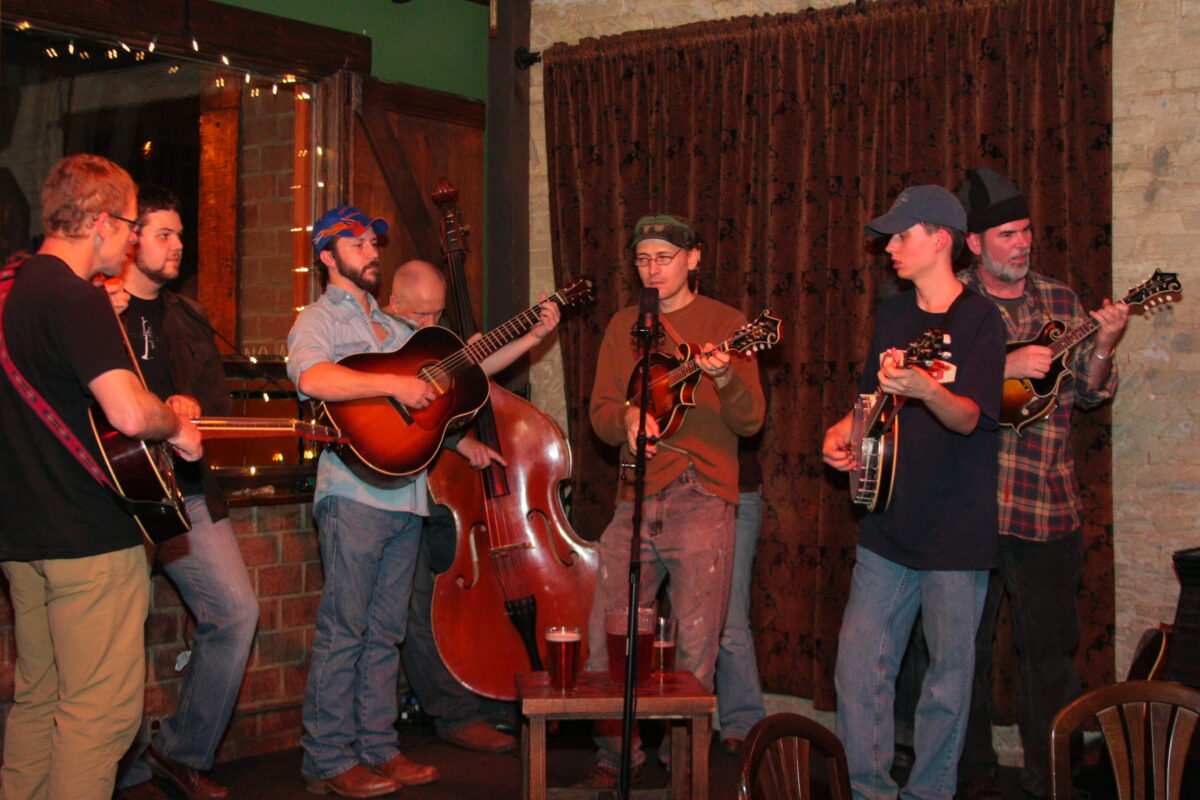
[This article goes back to January, 2011 when I was living in Asheville, North Carolina. There’s a legendary pub there called “Jack of the Wood”. Every Thursday night was (is?) “Bluegrass Jam” night. The locals and tourists come down to eat, drink, and listen to live bluegrass music. The local musicians come down to pick and get free beer.]
I’ve talked plenty of times about the picking at Jack of the Wood. And I’ve often wished that I had pictures. I mean, every week we see flashes going off throughout the room – I assume we’re becoming part of somebody’s “My visit to Asheville” Facebook album.
But last week, a guy named Jai Beasley spent the whole evening taking pictures and I persuaded him to sell me a few images. Here’s how I spend my Thursday evenings.
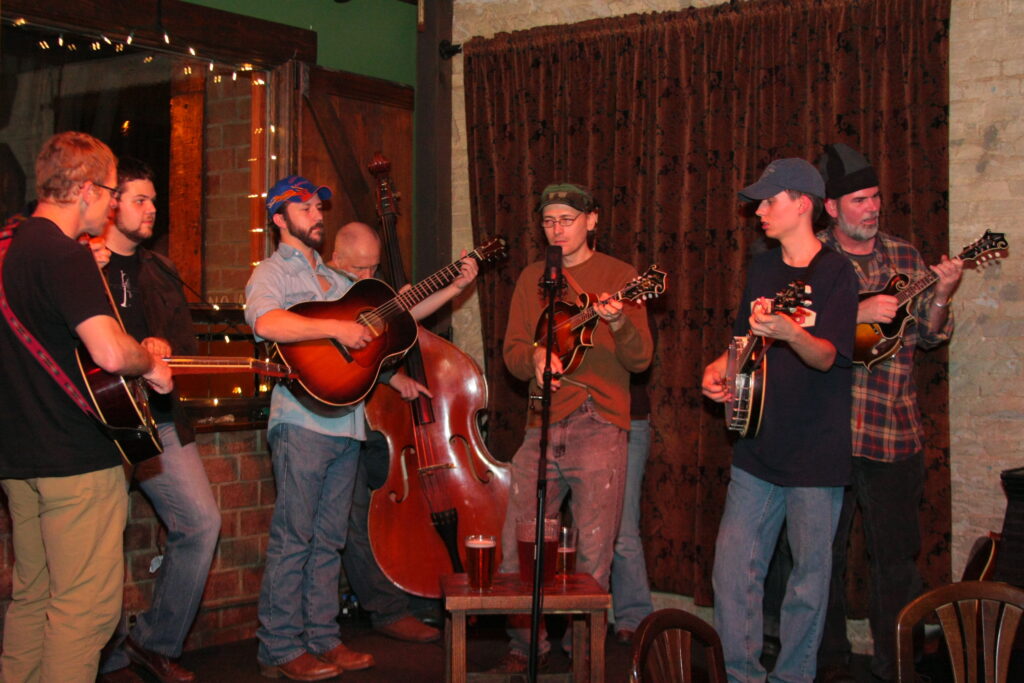
There’s a guy who was a regular there back then – Jon Stickley. Jon’s a stupendously nice guy and I’m honored to pick with him. The night that all these pictures got taken, I turned to John and said, “Do you ever think about how this is kind of magic? I mean, a bunch of people – many of whom barely know each other… we take these instruments made of wood and string, and this amazing music comes out of it and people are happy and smile and dance…”
Jon, a professional bluegrass musician, stared back at me. “Man, that’s all I think about.”
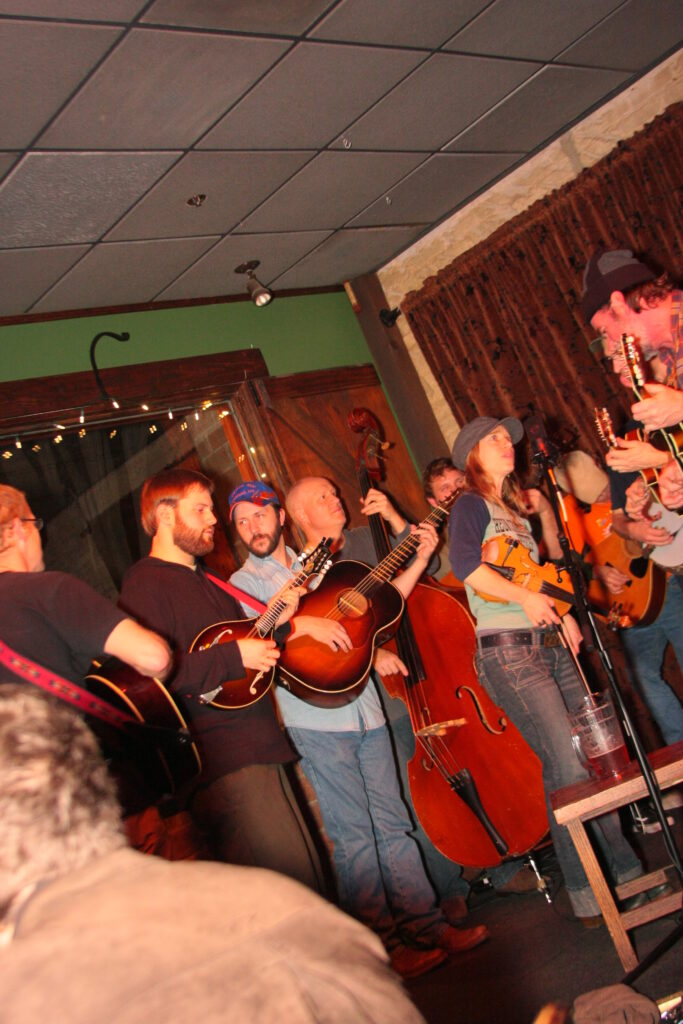
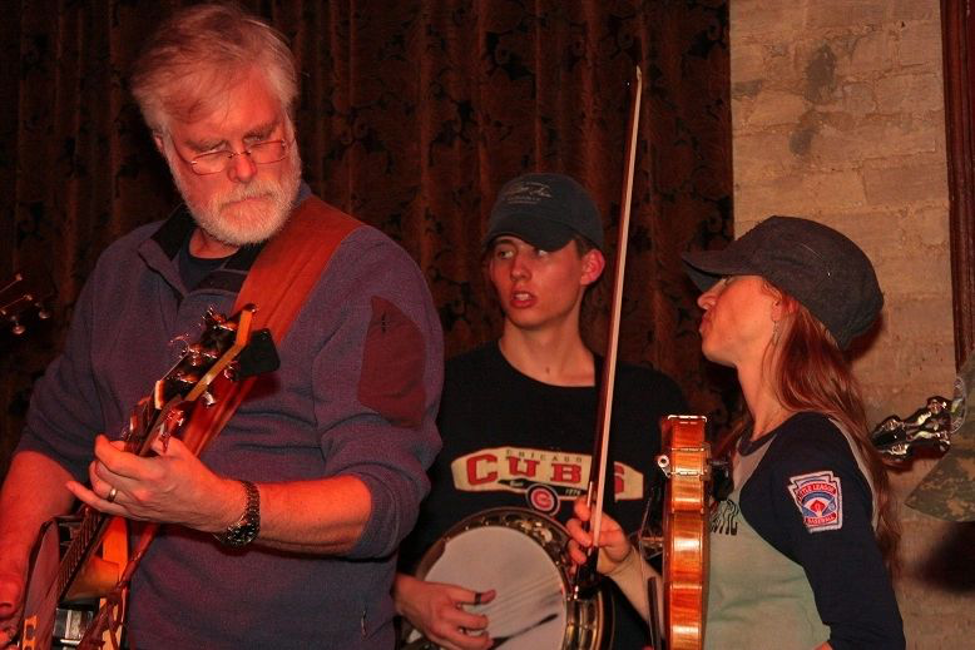
[Updates from 2022]
John now fronts his own trio, the “Jon Stickley Trio”. You’ll note that the fiddle player in that trio, Lindsay Pruett, appears in some of the pictures from 2011.
Another reflection from ten years on. You’ll note that few of the musicians are smiling. It’s not that we’re not having fun – it’s that there’s a lot of concentration going on. I am reminded of a jam that we had at my house in Nashville when we lived there. We were fortunate and some very fine pickers showed up. I had also invited a member of my extended family who lives in Nashville. He plays guitar but is not really conversant with the bluegrass thing. During one song, I leaned over to him and said, “Do you want a break (solo)?” He shook his head. “No man – this is serious business.”
He meant that the music itself was serious business that required focus and concentration. And I also inferred that he didn’t feel comfortable taking a solo among the hot pickers around us. I get it – I’ve been there plenty of times. Weaving magic from wood and string is, indeed, serious business.
Living my Best Life
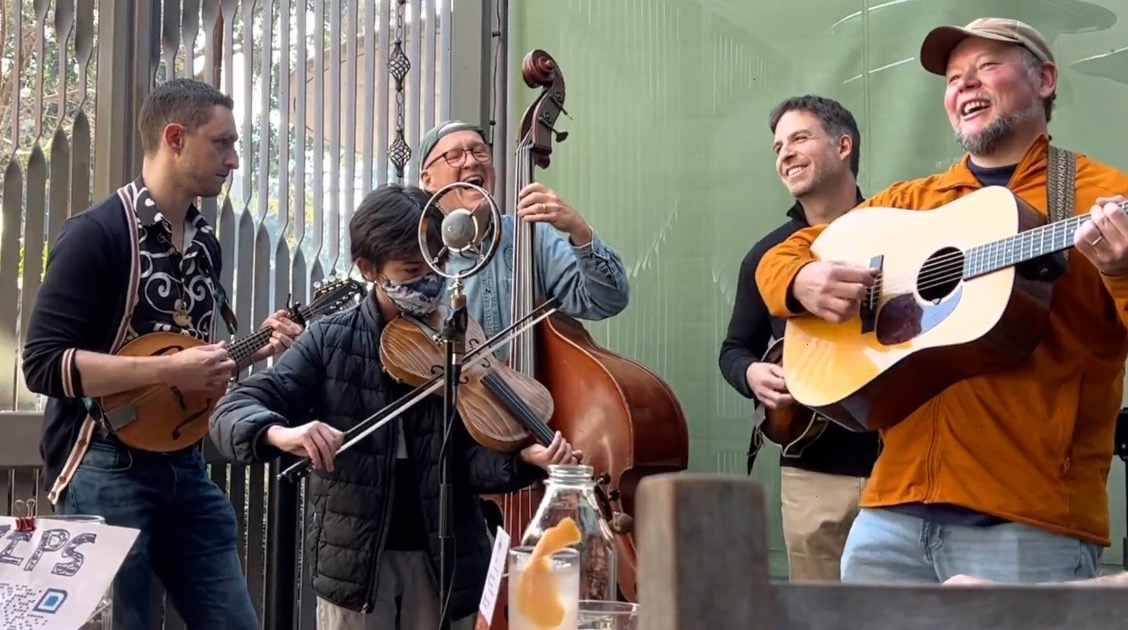
I don’t remember when I first performed music in front of people. But I was probably doing piano recitals around the age of 7-8 (1965, if you’re keeping score at home). I sang with the Landon Boy’s Choir on the Ranger Hal TV show in Washington, D.C. sometime around 1966 or 1967. And from then on, I was on one musical stage or another pretty much non-stop through college. I played in orchestras and jazz bands at school, and sang in the madrigal choir (yes, we wore silly clothes). I formed 2-3 rock bands and played at shows and dances. I played bass in the Duke Symphony, sang bass in the Duke Chapel Choir, and played viol de gamba in the Early Music group. I was the electric bass player for a series of performances of the Bernstein Mass, and the double bass player for a series of performances of Handel’s Messiah.
I loved it. I loved playing music with other people, I loved seeing the audience respond to the music, and the musicians respond to the audience. Yes, applause is the single most addictive drug there is – don’t let anybody tell you otherwise. I’ve rarely felt so alive as when I’ve been on a stage making music with good musicians.
Somehow, from the time that I left Duke until the past few years, I haven’t “played out,” much, as the expression goes. There are some number of reasons for that – none of them good. There were a few times when I’d have a regular opportunity to play publicly, such as my stint in Asheville, when I was jamming at Jack of the Wood. For a few years in there, Lisa and I sang in Schola Cantorum, a community choir on the Bay Area peninsula. It was a blast and I’m so glad we did it. But playing music didn’t occupy the space in my life that I wish it had. Why? Meh, that’s a topic for me and my therapist, but I’m here to tell you I’m back.
Few months ago, I bumped into Chris Quale, who is the band dad for a hot bluegrass band called Crying Uncle. His two sons, Miles and Teo, are half of the band, and he’s the bus driver, roadie, sound guy, manager, and CFO. But when he’s not that, or w*rking at his j*b, he’s a passionate, and very good acoustic guitar player.
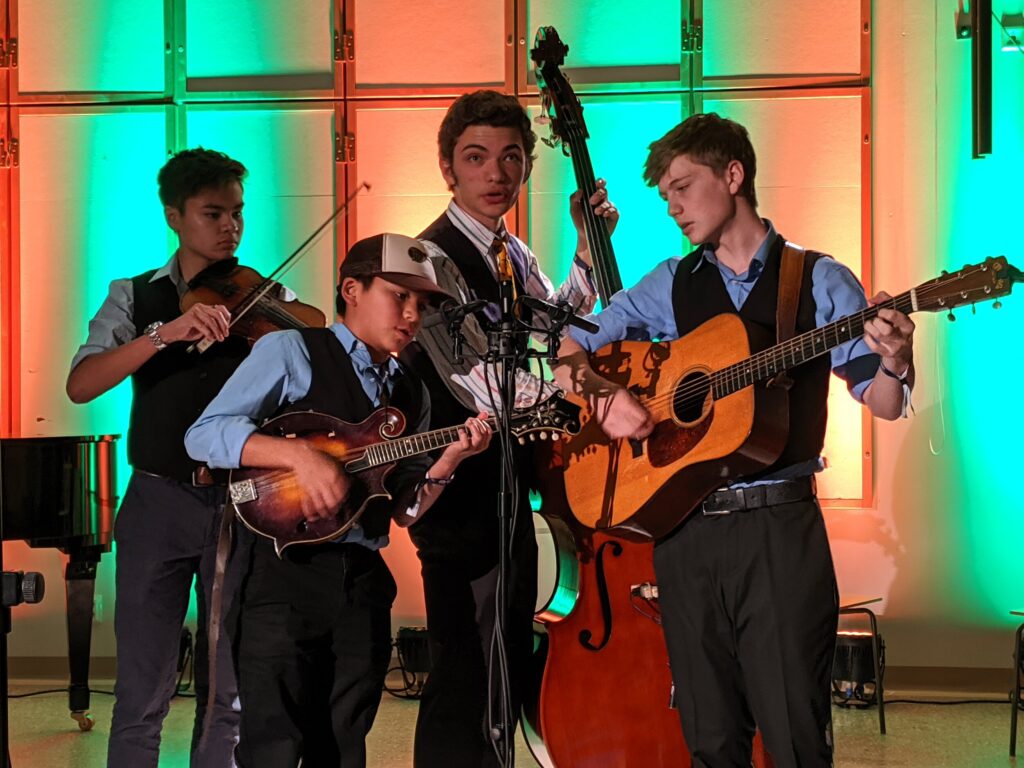
Chris invited me to pick with his mandolin buddy, Nick Khadder. They then invited me to invite my son, John Haupert (also a mandolin player) to join us. After a few evenings of us picking together, I thought, “You know, we’re actually good enough to play in front of people.” That’s when the universe giggled, and sent me an email saying that the Gather Kitchen, Bar and Market in Berkeley was looking for bluegrass bands to play at their alliteratively perfect Bluegrass Brunch.
Now, there’s a fact of the bluegrass world, first elucidated to me by Chris Flanders: “A gig is both necessary and sufficient to make a collection of musicians a band.” So I told the people at Gather that I had a band, and I told my fellow musicians that we had a gig. While neither of those statements was exactly true on its own, by the Flanders Theorem, together, they were both true.
For our first gig, we enlisted Nick’s daughter, Lucy, a dynamite fiddler. She’s also a very good bass player, but I won’t let her near my bass for fear that the band would then fire me. Also, I can’t play fiddle, so it made more sense for me to play bass. Anyway, the five of us had a blast the first time out, and the folks at Gather (both staff and patrons) seemed to enjoy us.
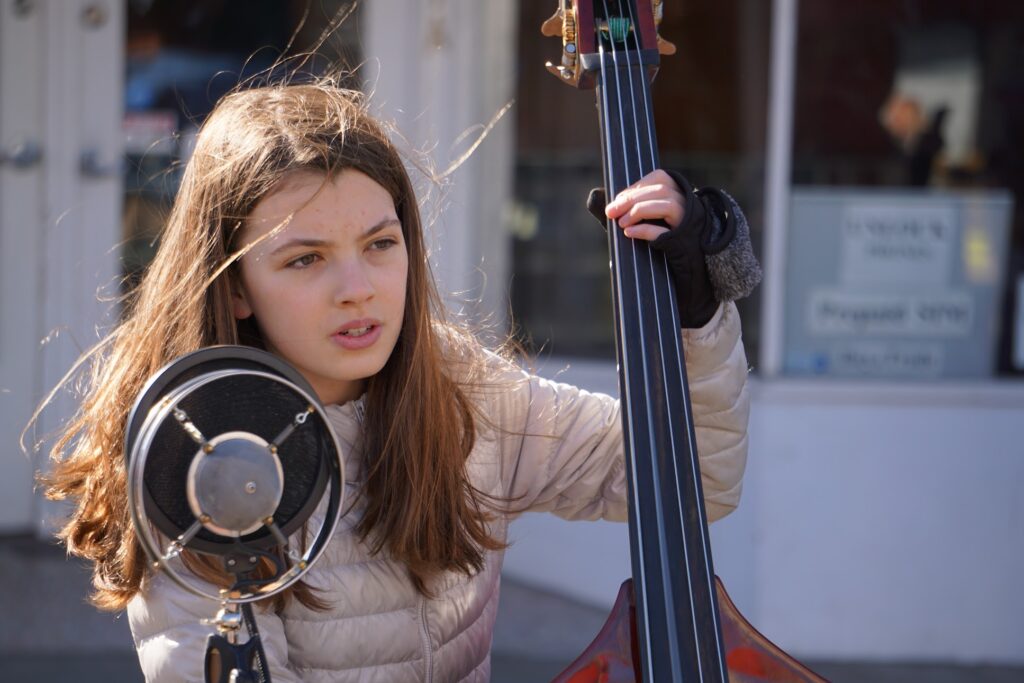
We went back on Saturday, January 29th, 2022. Unfortunately, Lucy couldn’t join us because she was in the recording studio (I can’t make this stuff up). But Chris can walk around his house and randomly tap three different very good fiddle players on the shoulder. In this particular random walk, he tapped Teo (a member of Crying Uncle) and Nikko.
So I spent a Saturday morning having an inexcusable amount of fun. I was playing music with friends in front of an appreciative crowd. John’s brother David, his wife Mary, daughter Elena, and my mother-in-law Liz, turned out to support us, as did members of Chris and Nick’s families.
I am an absurdly fortunate person, and try to lead with gratitude. I am thankful for my bandmates, and their families (including mine) for supporting this time away from other family responsibilities. I am grateful to all the musicians who have inspired and taught me over the years, so I’d play the best I could. And I am appreciative of the people at Gather – particularly Jodi Munson – who gave us a place to play and responded to our music so positively.
I also need to emphasize the sublime joy of playing music with young people. Every tine I get to pick with “kids” (these days, anybody under 30) I am renewed and invigorated. Their youthful energy pushes me and makes me play better. Importantly, their playing is a promise that people will play music as long as I live, and beyond. I find this gratifying. Miles, Teo, and Nikko Quale, and Lucy Khadder all randomly drop into our backyard fire pit picking sessions on occasion. When one of them shows up with a fiddle, the quality of the music triples, and all of us older guys just smile at each other. And speaking of gratitude, what a blessing to have these kids – all with absurdly busy lives – take time out to come pick with us.
What you see and hear here is not professional quality, either the video itself or the playing. But it is, as Chris says, objectively good music. And check out at 15:30, when John steps over right next to me. Musically speaking, it makes all the sense for the bass player and mandolin player in a bluegrass band to be close to each other – each of us is half of the drum kit. But that wasn’t what I was thinking about right then. No, I was thinking, “I’m playing live music with my son on a sunny afternoon while our audience eats brunch and digs the tunes. This is my best life.”
P.S., Teo isn’t in the video because who knows why, but the second set sparkled (a bluegrass brunch sparkly second set) because of him. So:
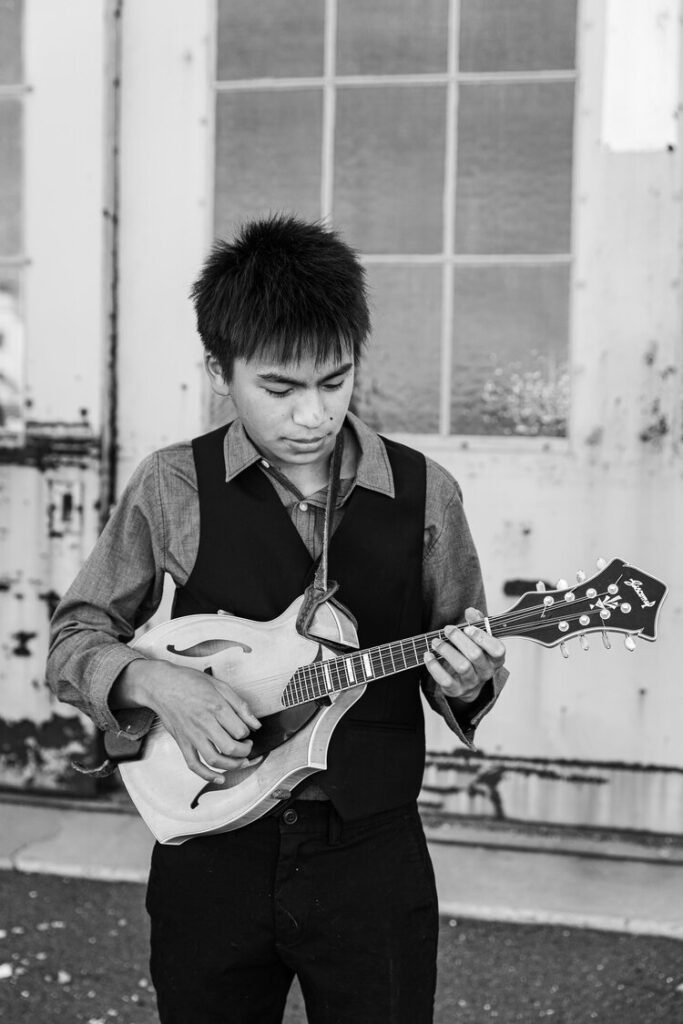
The Church Doors are Closing
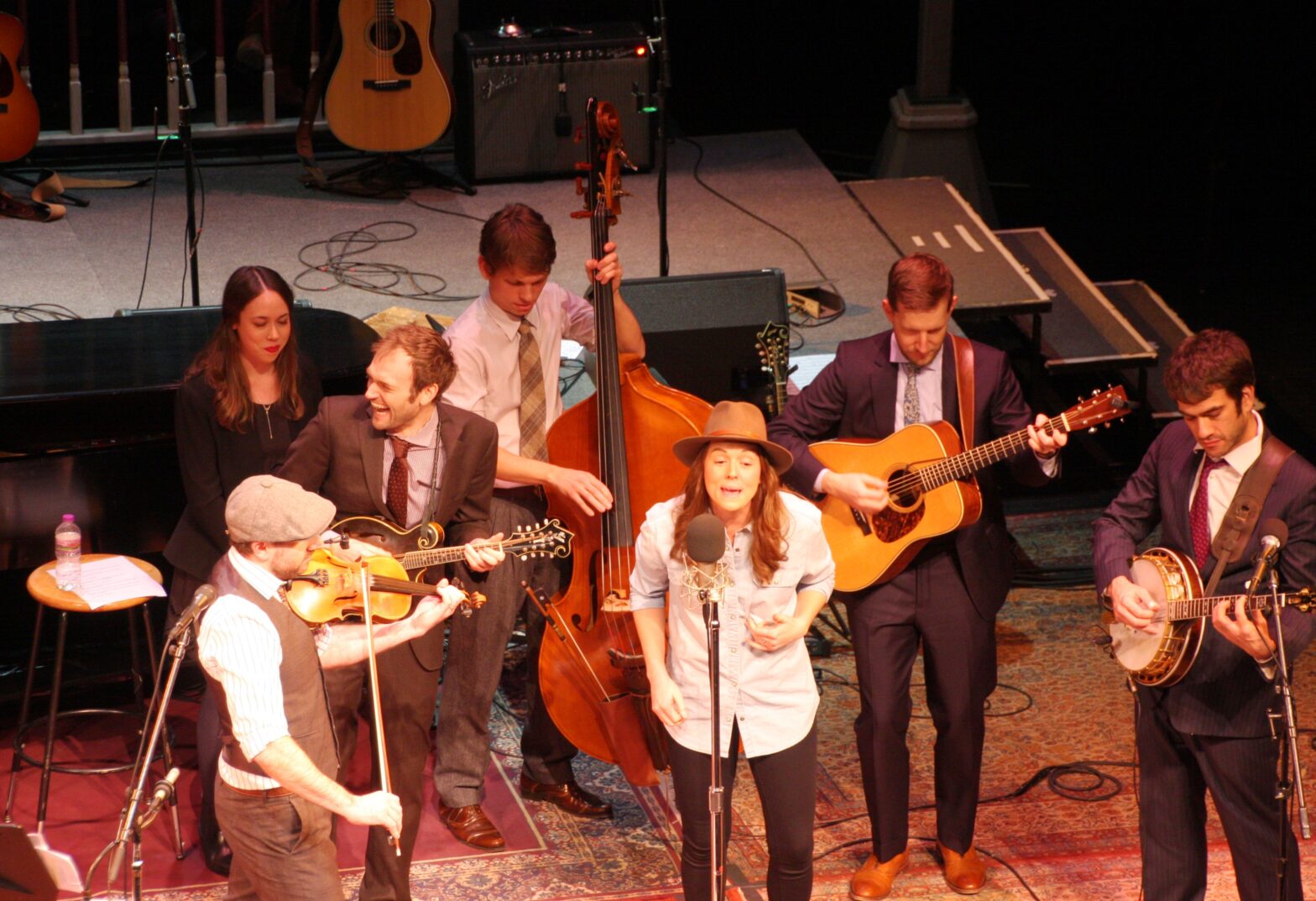
[This post originally appeared on June 20th, 2020]
Live From Here, a modern musical giant, is no more. Its parent, American Public Media, announced that LFH is yet another victim of Covid-19. When you can’t gather musicians and their fans together to celebrate live music, there’s not much alternative. I come here to bid it good-bye, and say thank you.
I converted to LFH in November of 2016. I was reeling from the Presidential election, and that was even before we knew just how unspeakably awful things were going to get. As if to wink out the last star in an ink-black night, the Universe took Leon Russell from us on November 13th. That Saturday, I was listening to the newly rebranded Live From Here. [1] At the end of the show, host and lead musician Chris Thile stepped up to the mic and said, “Oh man, we lost Leon Russell last week.” Here was a guy just a year older than my elder son, bowing to one of my musical heroes. He then gave a quick but accurate summary of Russell’s work, ending with, “He’s basically on every record you love.” Then they played a Leon Russell song. Not Song for You or Delta Lady – probably his most recognizable pieces. No, they played Prince of Peace, which reminds us that anybody we encounter in the street “… might be the Prince of Peace returning.” With no less than Trey Anastasio on guitar. I was 100% certain that the song choice was not a coincidence. These are my people – I am part of their congregation.
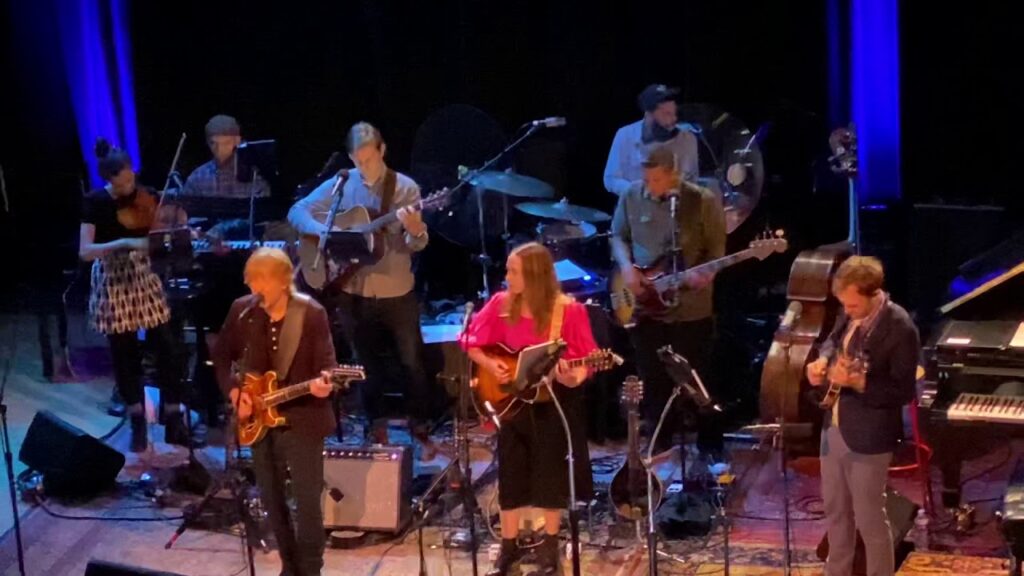
The constant refrain from the LFH stage was that music is more than a pastime. It is a central force of healing and harmony. And they were determined to spread that beauty as far and wide as they could in their two hours on the radio. Every Saturday, they’d hold a church of love and music at some lucky venue somewhere in the U.S.
And what an army for love it was. The LFH band, though it would morph and shift personnel, was always embarrassment of musical riches. I just want to type their names. Starting from the bass players: Mike Elizondo, Paul Kowert, Alan Hampton, Chris “Critter” Eldridge, Julian Lage, Brittany Haas, Gabe Witcher, Jeremy Kittel, Alex Hargreaves, Rich Dworsky, Brett Williams, Gabriel Kahane, Brad Mehldau, Ted Poor, Nate Smith, Marcus Gilmore. And the women who acted as foils for Thile and melted us with their singing and playing: Madison Cunningham, Sarah Jarosz, Gabby Moreno, Aoife O’Donovan, Rachel Price.
But the main celebrant was Thile, a once-in-generation mandolin player and McArthur Genius Grant recipient. When he played, his facial expressions and body language told you everything. No matter the musical genre, or whether he was in a lead or subordinate role, at that moment, in that place, he was playing the greatest music of all time, and he was all-in.
And speaking of genres, Live From Here personified the ethos that many music lovers live by: “There are two kinds of music: good and bad.” If it was good music, LFH was all about it. Nowhere was this more evident than the Musician’s Birthday segment (“It’s been a hell of a week for musicians’ birthdays!”). The band and singers would celebrate a handful of notable musicians’ birthdays with snippets of music. Multiple centuries? No genre duplicated in the list? “No problem – we got this.” And they did got it, because of the consummate virtuosity of every last person onstage. Check out this survey of Maybelle Carter, David Byrne, Peter Illych Tchaicovsky, bluegrass fiddler Benny Martin, and Stevie Wonder.
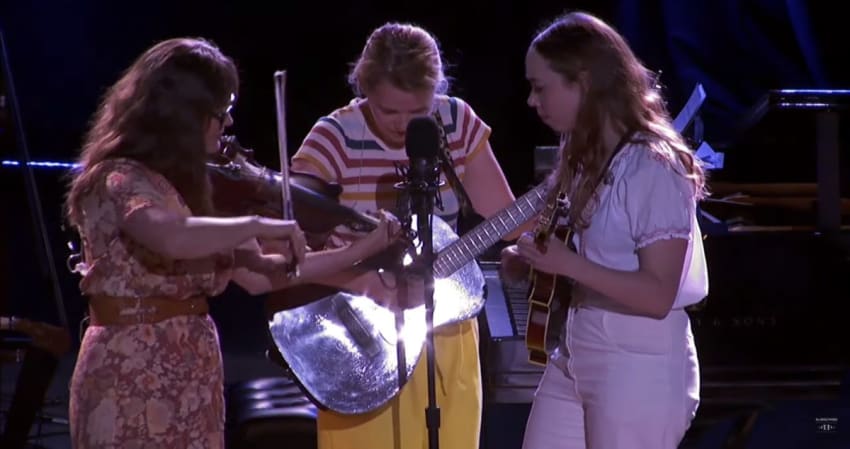
This seemingly effortless excellence made it possible for them to throw out the script on occasion. For a while, Thile would take tweets during a break, pick one (live, on stage) and tell the band, “Okay – we’re going to play <random tune>.” Or “Fiddle Tune Request Time”, where they took requests from the audience (“No! That one has words!”) and then played a medley of those tunes, each one probably better than you’ve ever heard it before, from just a wispy outline of a plan. Check this out: Thile, Chris Eldridge, and Jeremy Kittel dance across three classics. Watch bassist Mike Elizondo, a musical behemoth himself, grinning with delight at his stereo-center seat for the show.
This cauldron of musicality’s gravitational pull attracted giants old and new. Paul Simon, David Crosby, Randy Newman, Bruce Hornsby, Mandolin Orange, Vulfpeck, Emmanuel Ax, Milk Carton Kids, Pixies, Anaïs Mitchell, Common, Gregory Alan Isakov. The names go on. And so many of those names I didn’t know until I saw them on the LFH stage. They were in Durham, NC – my college hometown – and Thile said, “I have some friends in a band here and we thought it would be cool to have them on. So, please lose your minds for… Sylvan Esso!” Me: “Sylvan who?” Audience: [loses its mind]. And it went the other way. In St. Louis, they had the entire St. Louis Symphony Orchestra, led by Gemma New. I thought, “How many of the people in the audience have never seen a professional symphony orchestra live? And how many of those people are going to have their minds blown?” If the audience response to Mozart was any indication, quite a few.
Let’s talk about the audience. AKA “the congregation”. I was in it a handful of times, and it was, indeed, church. The crowd was musically hip, politically liberal, and ready to go wherever the LFH bus went. Yes, they – we – were canonical “NPR”, but if the Sunday go-to-meeting clothes fit, wear them with pride. They sang along, they participated (I will forever regret that I never got to yell “Old Dangerfield!” for Fiddle Tune Request Time). And they applauded and cheered their brains out for whatever happened onstage. They were as much a part of the experience as Thile and the other musicians; without them, the show simply couldn’t be.
Before I go, I will leave you with a smattering of hints for mining the Live From Here vein. I can only wish for you that you’ll disappear into it for hours and come out centered, warmed, and content.
- The band plays Weather Report’s River People. You need to listen to this twice. The first time, just enjoy the groove, not least Thile’s body language when the synth fires up. And dig Brittany and Critter, both of whom grew up in the bluegrass world, crushing jazz fusion. The second time through, close your eyes and focus on Mike Elizondo channeling Jaco Pastorius on bass.
- Sarah Jarosz is a Grammy-winning singer, songwriter, and instrumental virtuoso. She all but defines the “Americana” genre. But LFH allowed her to release her inner Liz Fraser, [2] Natalie Maines, and Billie Eilish.
- Here’s a sense of the musical virtuosity onstage. Violin legend Hillary Hahn plays the Bach Double Violin Concerto with Thile. But the unsung hero here is bass deity Paul Kowert, whose continuo work provides the entire foundation on which the melody rests. I’m a bass player – I know how hard this is – but Kowert does it with a delicate touch and pure elegance. I’m actually a bit miffed because Hahn never gives him the time of day during the piece. I hope and trust that she gets how crucial his contribution is, but I wish she’d at least tossed one look his way.
- One of the best segments of the show was the occasional “Fast AF Fiddle Tunes”. [3] Here’s Brittany Haas “taking us to fiddle camp.” I first learned of the tune Half Past Four here and it’s become a favorite. Note during that one where Sarah Jarosz, back on home fiddle tune turf, frails the hell out of the piece, looking completely blissed out. Every time I watch this video, I see her and the others’ faces and think, “This is why we play music. For those moments when we are floating in a bubble of sound and beauty with our fellow players.” There isn’t a better feeling.
N.B. to the violin/fiddle players: Occasionally Brittany lifts her head off the fiddle’s chin rest, destroying the classic violin player posture. But then she looks like the old Appalachian fiddlers, many of whom played with the fiddle tucked up against their shoulder. My narrative is that Brittany has simply surrendered the instrument to a previous incarnation of herself, who was born in 1896 in southwestern Virginia. - You can’t talk about Live From Here without talking about Aoife O’Donovan. She was one of the most frequent Thile foils at the pulpit, and they have a special musical bond. She sometimes performs with Punch Brothers (he calls her “The first Punch Sister”) and she was the only guest musician on the Goat Rodeo sessions (i.e. she was jamming with Yo-Yo Ma). Here she is singing happy birthday to Joni Mitchell. Listen to the audience swoon.
- Sara Watkins, the fiddle superstar of Nickel Creek and I’m With Her, owns the stage and puts the audience in her pocket with this cover of Nikka Costa’s Like A Feather. Pure attitude.
- If you’re into music, you know how complex and layered Good Vibrations is. It’s Brian Wilson at the height of his compositional and studio engineering craft. Nobody would dare try to reproduce it live. Unless you’re Live From Here. Then you just mix Punch Brothers with I’m With Her, add Rich Dworsky and Ted Poor, cue the Farfisa organ, and you’re off to the beach.
- I’ll end with this. Here, Thile summarizes the Live From Here credo, the audience sings along, and for a few minutes, in the midst of nothing being right, all is right with the world.
I remember 1980 vividly. Reagan was elected and I was scared. A month later, John Lennon was murdered, and I wondered how we’d survive. Somehow we did, and 28 years later, I’d sit in an Asheville movie theater with tears of joy in my eyes watching a Black man being sworn in as President. The night came crashing back down just eight short years later, and in its aftermath Leon Russell was gone. I wish that in 1980 there’d been the light in the darkness that I’ve had the past four years, bringing me musical solace every Saturday, Live, From Here.
If you are a member of the LFH production family – whether your name is Chris Thile or you are the person who laid out the sandwiches backstage – thank you. You have brought musical beauty into my life and I am better for it.
Pax vobiscum.
_____________________________________________________________
[1] LFH was technically a continuation of Garrison Keillor’s Prairie Home Companion. They had wisely distanced themselves from him and PHC – you can look up the details.
[2] Here’s where you see Thile investing 100%, no matter his role. The mandolin is playing a part done by a programmed percussion generator. Doesn’t matter – if he is to be an echoing slow-decay percussion machine, then he will be the best one of those there is. Note also Noam Pikelny, the Bela Fleck of his generation. Another synth part. Another perfectly executed repetitive drone, by hand. This is consummate musicianship.
[3] Sadly, it too got rebranded, probably a nod to the family-friendly format. But the intent was always there.